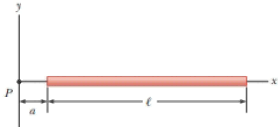
Concept explainers
A uniformly charged filament lies along the x axis between x = a = 1.00 m and x = a + ℓ = 3.00 m as shown in Figure P25.66. The total charge on the filament is 1.60 nC. Calculate successive approximations for the electric potential at the origin by modeling the filament as (a) a single charged particle at x = 2.00 m, (b) two 0.800-nC charged particles at x = 1.5 m and x = 2.5 m, and (c) four 0.400-nC charged particles at x = 1.25 m, x = 1.75 m, x = 2.25 m, and x = 2.75 m. (d) Explain how the results compare with the potential given by the exact expression

(a)
The electric potential due to single charge particle.
Answer to Problem 25.66AP
The electric potential due to single charge particle is
Explanation of Solution
Given info: The total charge on the filament is
Formula to calculate the electric potential due to point change is,
Here,
Substitute
Conclusion:
Therefore, the electric potential due to single charge particle is
(b)
The electric potential due to two charged particles.
Answer to Problem 25.66AP
The electric potential due to two charged particles is
Explanation of Solution
Given info: The charge on two particles is
Formula to calculate the total electric potential tow charge particles is,
Here,
Substitute
Conclusion:
Therefore, the electric potential due to two charged particles is
(c)
The electric potential due to four charged particles.
Answer to Problem 25.66AP
The electric potential due to four charged particles is
Explanation of Solution
Given info: The charge on four particles is
Formula to calculate the total electric potential tow charge particles is,
Here,
Substitute
Conclusion:
Therefore, the electric potential due to four charged particles is
(d)
The comparison between the electric potential due to charged filament and the calculated value of electric potential in part (a), part (b) and part (c).
Answer to Problem 25.66AP
The calculated value of electric potential due to charged filament is
Explanation of Solution
The total charge on the filament is
The given expression of the electric potential is,
Here,
Substitute
The electric potential due to charged filament is
Conclusion:
Therefore, the calculated value of electric potential is
Want to see more full solutions like this?
Chapter 25 Solutions
Bundle: Physics for Scientists and Engineers, Technology Update, 9th Loose-leaf Version + WebAssign Printed Access Card, Multi-Term
- Plz solution should be complete No chatgpt pls will upvote .arrow_forwardA box with friction coefficient of 0.2 rests on a 12 foot long plank of wood. How high (in feet) must one side of the plank be lifted in order for the box to begin to slide?arrow_forwardWhat is a good general rule to follow in order to find the best choice of coordinate system to solve a dynamics problem?arrow_forward
- What is the meaning of a first order approximation?arrow_forwardNo chatgpt pls will upvote Already got wrong chatgptarrow_forwardA hydrogen atom has just a single electron orbiting the nucleus, which happens to be a single proton without any neutrons. The proton is positively charged, the electron negatively, but both with the same magnitude of charge given by e=1.602x10-19C. The mass of an electron is 9.11x10-31kg, and the proton is 1.67x10-27kg. Find the ratio of the electrostatic to the gravitational force of attraction between the electron and the proton in hydrogen. \arrow_forward
- What is the third law pair to the normal force as you sit in a chair? What effect does the sun's pull on earth have in terms of third law pairs?arrow_forwardUsing Newton's 2nd law, show that all objects subject to the pull of gravity alone should fall at the same rate. What is that rate?arrow_forwardNo chatgpt pls will upvotearrow_forward
 Physics for Scientists and Engineers: Foundations...PhysicsISBN:9781133939146Author:Katz, Debora M.Publisher:Cengage Learning
Physics for Scientists and Engineers: Foundations...PhysicsISBN:9781133939146Author:Katz, Debora M.Publisher:Cengage Learning Physics for Scientists and Engineers with Modern ...PhysicsISBN:9781337553292Author:Raymond A. Serway, John W. JewettPublisher:Cengage Learning
Physics for Scientists and Engineers with Modern ...PhysicsISBN:9781337553292Author:Raymond A. Serway, John W. JewettPublisher:Cengage Learning Principles of Physics: A Calculus-Based TextPhysicsISBN:9781133104261Author:Raymond A. Serway, John W. JewettPublisher:Cengage Learning
Principles of Physics: A Calculus-Based TextPhysicsISBN:9781133104261Author:Raymond A. Serway, John W. JewettPublisher:Cengage Learning Physics for Scientists and Engineers, Technology ...PhysicsISBN:9781305116399Author:Raymond A. Serway, John W. JewettPublisher:Cengage Learning
Physics for Scientists and Engineers, Technology ...PhysicsISBN:9781305116399Author:Raymond A. Serway, John W. JewettPublisher:Cengage Learning Physics for Scientists and EngineersPhysicsISBN:9781337553278Author:Raymond A. Serway, John W. JewettPublisher:Cengage Learning
Physics for Scientists and EngineersPhysicsISBN:9781337553278Author:Raymond A. Serway, John W. JewettPublisher:Cengage Learning College PhysicsPhysicsISBN:9781305952300Author:Raymond A. Serway, Chris VuillePublisher:Cengage Learning
College PhysicsPhysicsISBN:9781305952300Author:Raymond A. Serway, Chris VuillePublisher:Cengage Learning





